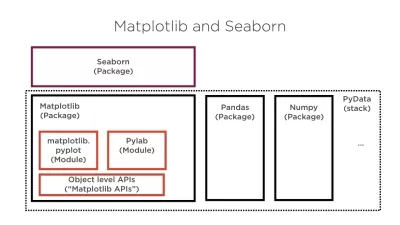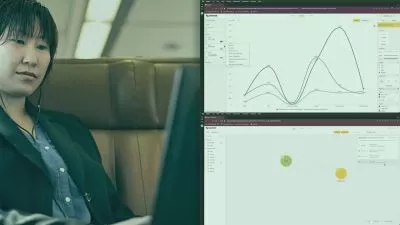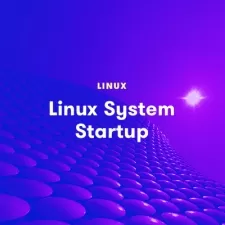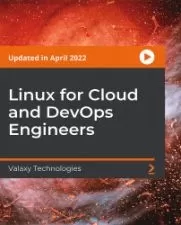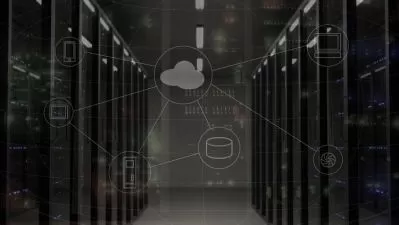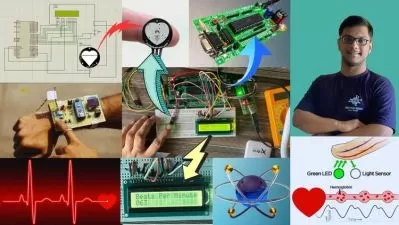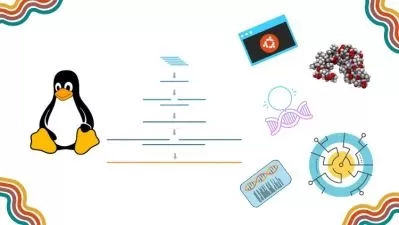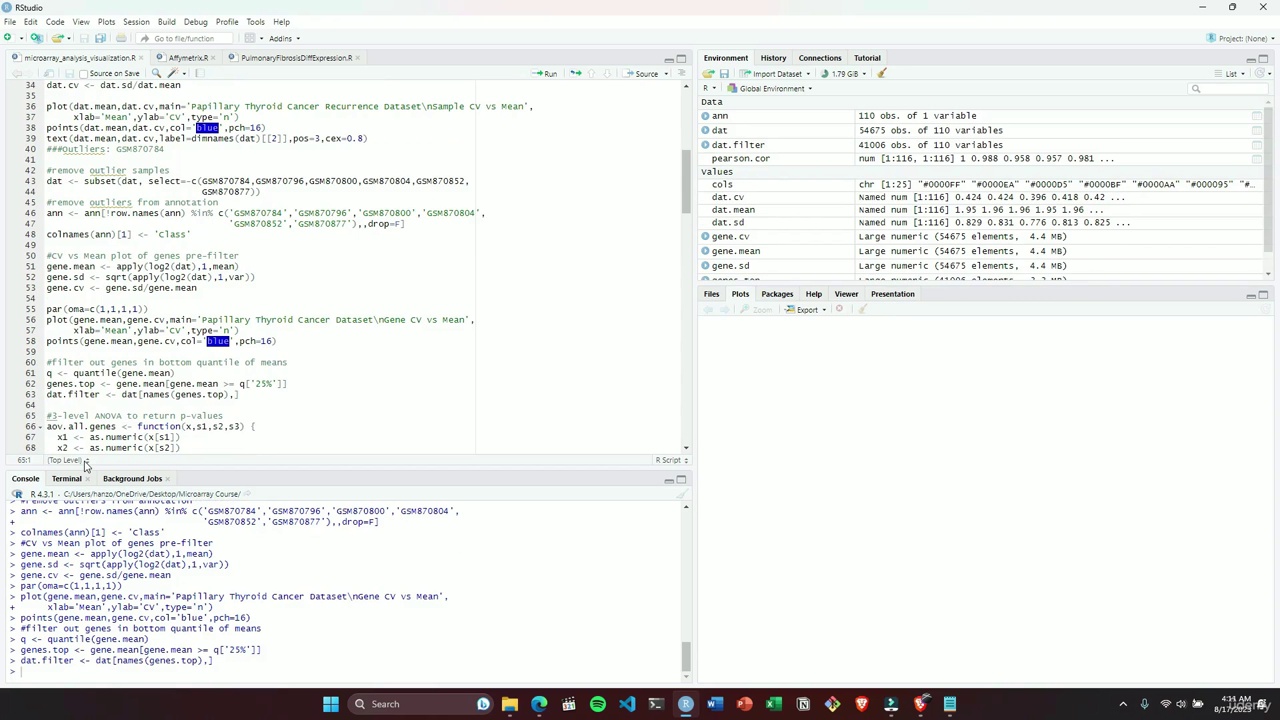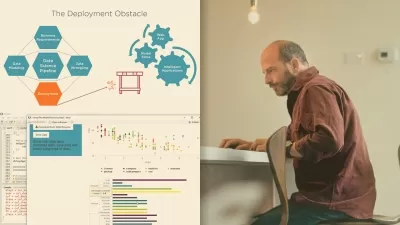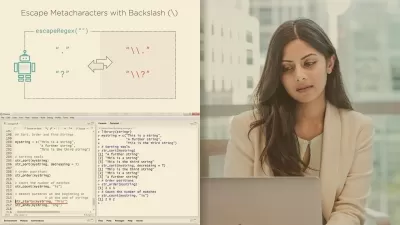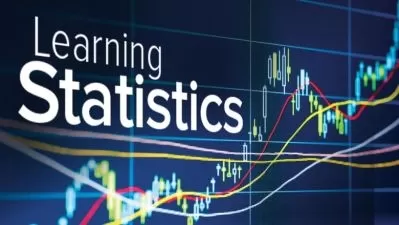Advanced Bioinformatics Data Analysis: Python, R, and Linux
Abdul Rehman Ikram
9:16:26
Description
Master Advanced Bioinformatics Data Analysis with Python, R, and Linux: Uncover Insights from Biological Data
What You'll Learn?
- Perform Data Preprocessing and Cleaning: Students will learn how to clean and preprocess biological data using Python and R. This includes techniques for handli
- Apply Common Bioinformatics Algorithms: Learners will gain proficiency in implementing and applying common bioinformatics algorithms and tools. This includes se
- Visualize Biological Data: Students will develop skills in creating meaningful visualizations for biological data. They will learn to use libraries like Matplot
- Analyze Genomic and Proteomic Data: This course will enable students to work with genomic and proteomic data, including DNA sequences, gene expression data, and
- Interpret Results and Draw Biological Insights: After completing the course, learners will be able to interpret the results of bioinformatics analyses and draw
Who is this for?
What You Need to Know?
More details
DescriptionAdvanced Bioinformatics Data Analysis: Python, R, and Linux
Welcome to "Advanced Bioinformatics Data Analysis: Python, R, and Linux," a comprehensive course designed to equip you with the advanced skills and knowledge needed to excel in the dynamic field of bioinformatics. Whether you're a biologist seeking to harness the power of computational tools, a data scientist looking to specialize in genomics, or a curious learner eager to explore the fascinating intersection of biology and data analysis, this course is your gateway to mastering bioinformatics.
Course Overview
Unlock the Potential of Biological Data
The era of big data has ushered in a new age of discovery in the life sciences. Biological data, encompassing genomics, proteomics, and beyond, holds the key to solving complex biological questions, from understanding the genetic basis of diseases to unraveling the mysteries of evolution. This course empowers you to unlock the potential of biological data by providing hands-on experience in advanced data analysis techniques.
Master Python, R, and Linux
The course's foundation is built on three pillars: Python, R, and Linux. Python and R are indispensable programming languages in bioinformatics, known for their versatility, rich libraries, and data analysis capabilities. Linux, the preferred operating system in scientific computing, offers unparalleled control and efficiency. Throughout the course, you'll become proficient in these essential tools, gaining the technical prowess required to tackle complex bioinformatics challenges.
What You'll Learn
This comprehensive course covers a wide array of topics, ensuring you have a holistic understanding of advanced bioinformatics data analysis. Here's a glimpse of what you'll master:
1. Data Preprocessing and Quality Control
Before embarking on any analysis, you'll learn how to clean and preprocess biological data, ensuring its accuracy and reliability. Techniques for handling missing data, outlier detection, and data normalization will become second nature to you.
2. Genomic Data Analysis
Genomic data, including DNA sequences and genetic variation, is at the heart of many bioinformatics studies. You'll delve into sequence alignment, variant calling, and genome-wide association studies (GWAS), unraveling the secrets encoded within genomes.
3. Proteomic Data Analysis
Proteins are the workhorses of biology, and their analysis is crucial for understanding cellular processes. You'll explore protein structure prediction, functional annotation, and differential expression analysis, gaining insights into the world of proteomics.
4. Biological Data Visualization
A picture is worth a thousand words, and this holds true in bioinformatics. You'll become skilled in creating meaningful visualizations using libraries like Matplotlib, Seaborn, and ggplot2, allowing you to communicate your findings effectively.
5. Linux for Bioinformatics
Mastering Linux is essential for bioinformatics work. You'll learn the command-line interface, shell scripting, and how to harness the power of the Linux environment for data analysis, making you a proficient Linux user.
6. Advanced Topics in Bioinformatics
As you progress, you'll tackle advanced topics such as motif discovery, phylogenetic tree construction, and metagenomics analysis. These topics will challenge and expand your bioinformatics skill set.
7. Real-World Projects
Theory alone won't make you an expert. Throughout the course, you'll engage in hands-on projects that simulate real-world bioinformatics challenges. These projects will give you the confidence and experience needed to excel in practical applications.
8. Biological Insights and Research
Ultimately, the goal of bioinformatics is to derive meaningful biological insights. You'll learn how to interpret your analysis results in a biologically relevant context, making your work valuable to the scientific community.
Who Should Take This Course?
This course is designed for a diverse audience:
Biologists and Life Scientists: Enhance your research by incorporating computational techniques and data analysis into your work.
Data Scientists and Analysts: Specialize in bioinformatics and apply your data analysis expertise to biological data.
Students and Researchers: Whether you're a student pursuing a degree in biology or an experienced researcher, this course will expand your bioinformatics toolkit.
Healthcare and Medical Professionals: Genomic data is becoming increasingly important in healthcare. Learn how to analyze this data to inform medical decisions.
Computer Scientists: Leverage your programming skills to address biological questions and contribute to cutting-edge research.
Career Changers: Transition into a rewarding career in bioinformatics with a solid foundation in data analysis and programming.
Enthusiastic Beginners: If you have a strong interest in bioinformatics and a willingness to learn, this course provides a gentle yet comprehensive introduction.
Prerequisites
This course is designed to be accessible to a wide range of learners, and there are no strict prerequisites. However, the following recommendations will help you get the most out of the course:
Basic Programming Knowledge: Familiarity with programming concepts is helpful but not required. The course caters to learners with varying levels of programming experience.
Biology Fundamentals: Understanding fundamental biology concepts, such as DNA, RNA, and proteins, will enhance your comprehension of the course content. However, the course provides background information as needed.
Access to a Computer: You'll need a computer with internet connectivity to access course materials, code examples, and bioinformatics tools.
Software and Tools: It's beneficial to have Python and R installed on your computer. Instructions for installation and setup may be provided as part of the course.
Curiosity and Eagerness to Learn: A strong desire to explore bioinformatics and a curious mindset are essential for success in this course.
Course Format
The course is structured to accommodate learners of all backgrounds and skill levels. It includes:
Video Lectures: Engage with comprehensive video lectures that explain concepts and guide you through practical examples.
Hands-on Exercises: Apply what you've learned through hands-on exercises and projects that reinforce your skills.
Quizzes and Assessments: Test your knowledge and track your progress with quizzes and assessments throughout the course.
Discussion Forums: Connect with fellow learners, ask questions, and collaborate on bioinformatics challenges in dedicated discussion forums.
Real-World Projects: Work on practical projects that simulate real bioinformatics scenarios, helping you build a portfolio of valuable work.
Instructor Support: Access to instructor support and guidance for clarifying doubts and addressing questions.
Your Journey in Bioinformatics Starts Here
As the field of bioinformatics continues to evolve, the demand for skilled professionals who can unlock the secrets hidden in biological data is on the rise. This course empowers you to embark on a fulfilling journey into bioinformatics, where you'll gain the expertise to make meaningful contributions to the life sciences.
Are you ready to dive into advanced bioinformatics data analysis with Python, R, and Linux? Enroll today and embark on a transformative learning experience that will open doors to exciting career opportunities and groundbreaking research.
Who this course is for:
- Biologists and Life Scientists: Biologists, biochemists, geneticists, and other life science professionals who want to enhance their data analysis skills and leverage computational tools to extract meaningful insights from biological data.
- Data Scientists and Analysts: Data professionals with a background in programming who wish to specialize in bioinformatics and apply their data analysis expertise to biological datasets.
- Students and Researchers: Undergraduate and graduate students pursuing degrees in biology, bioinformatics, genetics, or related fields, as well as researchers in academia and industry seeking to expand their knowledge in bioinformatics.
- Healthcare and Medical Professionals: Healthcare practitioners, clinicians, and medical researchers interested in genomics and personalized medicine who want to understand how to analyze genomic and proteomic data.
- Computer Scientists: Computer science students and professionals interested in applying their programming skills to solve real-world biological problems.
- Career Changers: Individuals looking to transition into a career in bioinformatics who may not have prior experience but possess a strong interest in biology and data analysis.
- Enthusiastic Beginners: Anyone with a genuine interest in bioinformatics and a willingness to learn, regardless of their background or experience level. The course is designed to be accessible to beginners and gradually progress to more advanced topics.
Advanced Bioinformatics Data Analysis: Python, R, and Linux
Welcome to "Advanced Bioinformatics Data Analysis: Python, R, and Linux," a comprehensive course designed to equip you with the advanced skills and knowledge needed to excel in the dynamic field of bioinformatics. Whether you're a biologist seeking to harness the power of computational tools, a data scientist looking to specialize in genomics, or a curious learner eager to explore the fascinating intersection of biology and data analysis, this course is your gateway to mastering bioinformatics.
Course Overview
Unlock the Potential of Biological Data
The era of big data has ushered in a new age of discovery in the life sciences. Biological data, encompassing genomics, proteomics, and beyond, holds the key to solving complex biological questions, from understanding the genetic basis of diseases to unraveling the mysteries of evolution. This course empowers you to unlock the potential of biological data by providing hands-on experience in advanced data analysis techniques.
Master Python, R, and Linux
The course's foundation is built on three pillars: Python, R, and Linux. Python and R are indispensable programming languages in bioinformatics, known for their versatility, rich libraries, and data analysis capabilities. Linux, the preferred operating system in scientific computing, offers unparalleled control and efficiency. Throughout the course, you'll become proficient in these essential tools, gaining the technical prowess required to tackle complex bioinformatics challenges.
What You'll Learn
This comprehensive course covers a wide array of topics, ensuring you have a holistic understanding of advanced bioinformatics data analysis. Here's a glimpse of what you'll master:
1. Data Preprocessing and Quality Control
Before embarking on any analysis, you'll learn how to clean and preprocess biological data, ensuring its accuracy and reliability. Techniques for handling missing data, outlier detection, and data normalization will become second nature to you.
2. Genomic Data Analysis
Genomic data, including DNA sequences and genetic variation, is at the heart of many bioinformatics studies. You'll delve into sequence alignment, variant calling, and genome-wide association studies (GWAS), unraveling the secrets encoded within genomes.
3. Proteomic Data Analysis
Proteins are the workhorses of biology, and their analysis is crucial for understanding cellular processes. You'll explore protein structure prediction, functional annotation, and differential expression analysis, gaining insights into the world of proteomics.
4. Biological Data Visualization
A picture is worth a thousand words, and this holds true in bioinformatics. You'll become skilled in creating meaningful visualizations using libraries like Matplotlib, Seaborn, and ggplot2, allowing you to communicate your findings effectively.
5. Linux for Bioinformatics
Mastering Linux is essential for bioinformatics work. You'll learn the command-line interface, shell scripting, and how to harness the power of the Linux environment for data analysis, making you a proficient Linux user.
6. Advanced Topics in Bioinformatics
As you progress, you'll tackle advanced topics such as motif discovery, phylogenetic tree construction, and metagenomics analysis. These topics will challenge and expand your bioinformatics skill set.
7. Real-World Projects
Theory alone won't make you an expert. Throughout the course, you'll engage in hands-on projects that simulate real-world bioinformatics challenges. These projects will give you the confidence and experience needed to excel in practical applications.
8. Biological Insights and Research
Ultimately, the goal of bioinformatics is to derive meaningful biological insights. You'll learn how to interpret your analysis results in a biologically relevant context, making your work valuable to the scientific community.
Who Should Take This Course?
This course is designed for a diverse audience:
Biologists and Life Scientists: Enhance your research by incorporating computational techniques and data analysis into your work.
Data Scientists and Analysts: Specialize in bioinformatics and apply your data analysis expertise to biological data.
Students and Researchers: Whether you're a student pursuing a degree in biology or an experienced researcher, this course will expand your bioinformatics toolkit.
Healthcare and Medical Professionals: Genomic data is becoming increasingly important in healthcare. Learn how to analyze this data to inform medical decisions.
Computer Scientists: Leverage your programming skills to address biological questions and contribute to cutting-edge research.
Career Changers: Transition into a rewarding career in bioinformatics with a solid foundation in data analysis and programming.
Enthusiastic Beginners: If you have a strong interest in bioinformatics and a willingness to learn, this course provides a gentle yet comprehensive introduction.
Prerequisites
This course is designed to be accessible to a wide range of learners, and there are no strict prerequisites. However, the following recommendations will help you get the most out of the course:
Basic Programming Knowledge: Familiarity with programming concepts is helpful but not required. The course caters to learners with varying levels of programming experience.
Biology Fundamentals: Understanding fundamental biology concepts, such as DNA, RNA, and proteins, will enhance your comprehension of the course content. However, the course provides background information as needed.
Access to a Computer: You'll need a computer with internet connectivity to access course materials, code examples, and bioinformatics tools.
Software and Tools: It's beneficial to have Python and R installed on your computer. Instructions for installation and setup may be provided as part of the course.
Curiosity and Eagerness to Learn: A strong desire to explore bioinformatics and a curious mindset are essential for success in this course.
Course Format
The course is structured to accommodate learners of all backgrounds and skill levels. It includes:
Video Lectures: Engage with comprehensive video lectures that explain concepts and guide you through practical examples.
Hands-on Exercises: Apply what you've learned through hands-on exercises and projects that reinforce your skills.
Quizzes and Assessments: Test your knowledge and track your progress with quizzes and assessments throughout the course.
Discussion Forums: Connect with fellow learners, ask questions, and collaborate on bioinformatics challenges in dedicated discussion forums.
Real-World Projects: Work on practical projects that simulate real bioinformatics scenarios, helping you build a portfolio of valuable work.
Instructor Support: Access to instructor support and guidance for clarifying doubts and addressing questions.
Your Journey in Bioinformatics Starts Here
As the field of bioinformatics continues to evolve, the demand for skilled professionals who can unlock the secrets hidden in biological data is on the rise. This course empowers you to embark on a fulfilling journey into bioinformatics, where you'll gain the expertise to make meaningful contributions to the life sciences.
Are you ready to dive into advanced bioinformatics data analysis with Python, R, and Linux? Enroll today and embark on a transformative learning experience that will open doors to exciting career opportunities and groundbreaking research.
Who this course is for:
- Biologists and Life Scientists: Biologists, biochemists, geneticists, and other life science professionals who want to enhance their data analysis skills and leverage computational tools to extract meaningful insights from biological data.
- Data Scientists and Analysts: Data professionals with a background in programming who wish to specialize in bioinformatics and apply their data analysis expertise to biological datasets.
- Students and Researchers: Undergraduate and graduate students pursuing degrees in biology, bioinformatics, genetics, or related fields, as well as researchers in academia and industry seeking to expand their knowledge in bioinformatics.
- Healthcare and Medical Professionals: Healthcare practitioners, clinicians, and medical researchers interested in genomics and personalized medicine who want to understand how to analyze genomic and proteomic data.
- Computer Scientists: Computer science students and professionals interested in applying their programming skills to solve real-world biological problems.
- Career Changers: Individuals looking to transition into a career in bioinformatics who may not have prior experience but possess a strong interest in biology and data analysis.
- Enthusiastic Beginners: Anyone with a genuine interest in bioinformatics and a willingness to learn, regardless of their background or experience level. The course is designed to be accessible to beginners and gradually progress to more advanced topics.
User Reviews
Rating
Abdul Rehman Ikram
Instructor's Courses
Udemy
View courses Udemy- language english
- Training sessions 62
- duration 9:16:26
- Release Date 2023/10/12






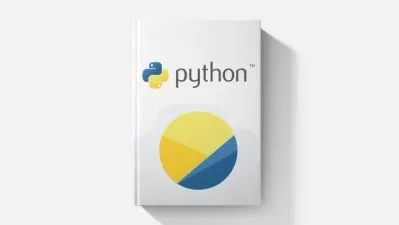





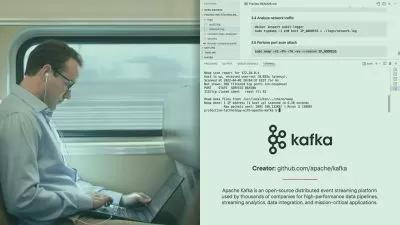

![Become a Data Scientist: SQL, Tableau, ML & DL [4-in-1]](https://traininghub.ir/image/course_pic/13291-x225.webp)





